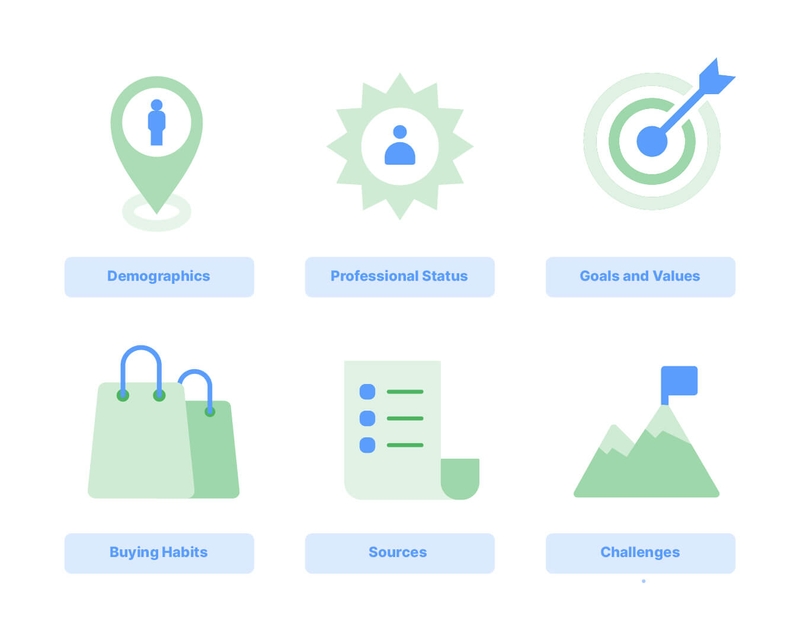What Is a Buyer Persona and How to Create Personas for Your Business?
One of the biggest secrets to running a successful marketing campaign is knowing your audience. In this blog post, we will walk you through the process of creating a buyer persona and explain how you can use it to connect with your customers, improve customer satisfaction and make the most of your campaigns.
8 min read

Petr Agulin
Apr 13, 2021

The ideal customer is one who is genuinely interested in the product or service that you are offering. However, making gratuitous assumptions on who that is can be unwise; if you don’t know exactly who you are talking to, it is nearly impossible to create targeted content that connects with your audience. Not to mention, getting it wrong and targeting customers who are unlikely to convert can result in wasting time, money, and resources. If you want the best chance of getting your customers’ attention and, more importantly, keeping them satisfied, you need to build an accurate buyer persona.
Buyer personas help you focus your energy on creating campaigns that are likely to attract high-quality leads, weeding out prospects who are not interested in what you are offering. Having a deep understanding of your customers is not only critical for attracting and converting leads, but it will also help you with optimizing your customer experience, improving your product development, and increasing client retention.
What Is A Buyer Persona
A buyer persona, also known as a customer persona, is a detailed representation of your target customer. Through market research and collecting data, you are able to identify specific attributes of your ideal customer; however, buyer personas go further than simply identifying demographics; you need to look at their behavioral traits, interests and even giving them a name. Along with identifying their attributes, you will need to understand their goals, pain points, and buying habits.

As it is essential that the buyer persona speaks directly to your target audience, you may need more than one persona. Developing multiple personas means that you can empathize with various perspectives and, therefore, speak to a larger pool of customers. Depending on your business structure, you may need multiple personas for different products, levels of service, or one for each step of the customer journey.
There is often some confusion between a buyer persona and a user persona. While a customer can be technically both a buyer and a user, generally, the two personas have different needs and wants from a product or service. A user persona regularly uses the product or service but has little to no say in the decision-making process; it is often created to empathize with those who will react to certain features, product developments, and upgrades. A buyer persona is a decision-maker in the purchasing process, meaning their needs and wants could be driven by more than just product features and include factors such as cost and scalability.
Benefits Of A Buyer Persona
Developing a buyer persona is the foundation of any successful marketing campaign; without it, you are unlikely to understand what attracts new customers and what drives them to make a purchase, meaning you can end up wasting time on the wrong messaging. Buyer personas enable you to tailor your content and messaging to attract an exact type of customer who is either likely to convert, give you the highest revenue, be a repeat customer or have the least competition.
However, personas are not specific to marketing; they should be used across your entire organization, particularly by management, sales, and product development. For example, in product development and product management, the insight that a buyer persona provides can impact certain product strategies, define new product features or no-go decisions. Buyer personas enable you to identify and qualify leads, allocate resources and design your strategy and products that cater to your market. Customers are at the center of every business and determining exactly who your customer is, enables you to tailor your strategies to their needs and wants.
Buyer Persona Characteristics
A buyer persona’s characteristics will vary depending on whether you are a B2B business or a B2C business. However, generally, the information you want to gather to define the buyer persona should consist of a combination of the following points:
Demographics
- Age
- Gender
- Location
- Income
- Marital Status
- Education
Professional Status
- Job Title
- Industry
- Company Size/Revenue Size
Goals and Values
- Personality Traits
- Professional Goals
- Personal Goals
- Beliefs
Buying Habits
- Role in the purchase process
- The frequency of buying
- Recent purchases made
Sources
- Preferred publications for reading
- Preferred social media platforms
Challenges
- Challenges faced
- Main pain points
Buyer Persona Example
Before we walk you through how to create a buyer persona, to get an idea of what one looks like, here is a generalized example of a persona for an IT company marketing specialist.
Rachel:
- Female
- Between 30 - 35
- Works as a Marketing Manager at IT Company “BeautifulSoup”
- Has an annual income of at least $40,000
- Has a bachelor’s degree in marketing and communications
- Mobile-driven - spends 3 hours per day on her smartphone, using Facebook, Twitter, and LinkedIn
- Organized and efficient, likes to make sure projects are finished on time.
- Likes to run a well-organized team
- Finds it frustrating when data management is sloppy and inconsistent
How To Create A Buyer Persona
Creating a customer persona is no simple task; it requires research, surveys, and interviews with your team, department heads, and internal and external customers. However, as a buyer persona gives you the knowledge to speak directly to the people who are interested in your products, the benefits speak for themselves; that is why we have put together four steps to help you create your buyer persona.
Step 1. Check Your Analytics
Chances are you will have a Customer Relationship Management System (CRM), a website with inbuilt analytics, or a point of sales system that can provide you with first-hand data about the customer base who are actively interacting with your company and your products. Accessing this customer data can provide you with valuable insights into your customers’ demographic, habits, wants, and needs. This information provides you with a great base to develop your buyer personas.
Step 2. Consult Your Department Heads
Before you begin building your buyer persona, it is essential to have a conversation with your internal stakeholders. While sales, marketing, and customer service are all working towards the same goal, due to their interactions with customers and the data they have collected, they may have different understandings of your current customer base and what makes them tick. Consult your department heads to find out what they perceive your customer’s needs, pain points, goals, and typical behavior traits are. Having their insights will enable you to get more valuable information from your research, surveys, and interview questions.
Once you have gathered insider knowledge from your colleagues and databases, you are ready to conduct first-hand research to find out exactly what your customers do.
Step 3. Customer Research
The best way to understand your customers is to speak to them directly; this can be through surveys, focus groups, or one-to-one interviews. To get an accurate and holistic understanding of your customers, you should interview existing customers, prospects and leads, ideal customers, and former customers. Asking questions enables you to better understand their behavior, their challenges, and what they are looking for, helping you refine your content and messaging.
Surveys: You can learn a lot about your target audience by sending out questionnaires and surveys. However, when creating the questions for your survey, remember that your objective is to better understand your customer’s needs and their behaviors and make sure that you tailor the questions in an unbiased and non-leading manner to get the most genuine answers. Depending on your contact list, you can send out a survey via email, post on social media, or call potential participants up on the phone; if you find that people are reluctant to do surveys, a great way to incentivize them is to offer a discount, gift card or some kind of prize.
Focus Groups and One-To-One Interviews: This can be more time-consuming than sending out surveys, so it is best first to qualify the customers you want to interview in a focus group or one-to-one through their survey answers. One-on-one and focus group interviews allow for more organic conversations, where customers are often more open about their pain points, challenges, or motivations than they would have been on a survey. You may be able to spot unique statements or pick up quotes that you can use in your campaign and messaging.
Step 4. Compiling Data
The final step of creating your persona is analyzing the data, identifying patterns and commonalities to develop accurate portraits of your personas. Depending on the research you have done, you may find that you have two personas that have stood out for different products, meaning you need to create multiple personas, one for each product. The aim is to make your persona sound like a real person, so using the data that you have collected, give your buyer a name, job title, and some defining characteristics, making sure to include their challenges, pain points, and goals.
Conclusion
The most effective way to reach your customers is to speak directly to them. The more you understand about your customers and prospects, the easier it is for you to reach and relate to them. Developing a buyer persona enables you to humanize your marketing messages and your sales content, enabling you to boost sales and improve brand loyalty.
Creating a buyer persona is a cost-effective process that helps you better understand what drives your customers. Along with providing valuable insight into your customers’ wants and needs, a buyer persona can benefit all sectors of your company—equipping your sales, marketing, customer service, and product development teams with the knowledge to refine strategies and processes to get the best results.


